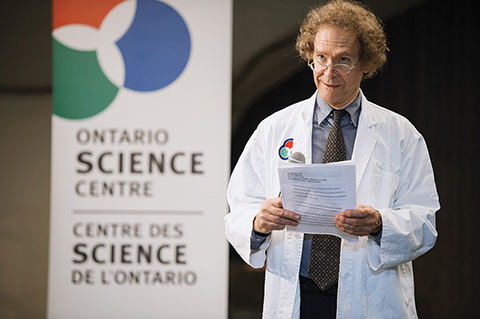Since 1969, the Ontario Science Centre has brought the mysteries of the natural world to life for more than 50 million visitors. One of the world’s first interactive museums, it inspires countless children to choose careers in science. David Sugarman (BSc 1983 UC, BEd 1986) has spent 30 years at the centre as a senior researcher, and is one of the people responsible for program development and public education. Here, he peers through the microscope with Cynthia Macdonald.
Who doesn’t love the science centre?
Touching the Van de Graaff generator and feeling your hair stand on end is a rite of passage for any Toronto kid. We’d never dare get rid of the Van de Graaff because it’s so iconic. At one point we even had a Van de Graaff in the science circus that went around the province.
Since you’ve been there, the world has seen incredible changes in technology, climate and neuroscience: I guess your exhibits have to change, just as the world does.
That’s true. In the mid-90s, we had an area called “The Information Highway.” Relatively few people had access to the web then, so we had computers set up for them to play the latest games. You can imagine how popular that was.
Do you think we are scientifically literate as a society?
Not nearly enough. And I find there’s a huge disparity between that literacy and the amount of information that’s available. We don’t think critically enough – not only about science but everything else, like politics. Many people seem to sleepwalk through life.
Around the turn of the millennium I read a book called The End of Science, which claimed that everything had been discovered already: Science was over.
It’s preposterous, of course! The tools we have now – take the Hubble telescope, for example – only reveal how much we still don’t know. Science is like a door that leads onto other doors. As soon as you say you’ve found it all out, you’re closing those doors.
Famous scientists such as Nobel laureates John Polanyi and the late Marie Curie don’t strike me as “mad.” They’re very distinguished – so where does the image of scientists as “mad” come from?
Scientists are intensely focused on their work – work that is often quite esoteric, and that can make them seem like odd ducks, I suppose. But that focus is understandable, because the world is so magical. Think about what’s going on underground – there are untold numbers of organisms in the ground beneath your feet. Outside, birds are singing: if they don’t get their songs right, they don’t get a mate. And the whole idea of life, that we’re part of an unbroken chain that goes back in time to the first bits of protoplasm – I mean, that’s just mind-blowing!
Watch: David Sugarman responds to the question “can it ever be too cold to snow?”
Recent Posts
People Worry That AI Will Replace Workers. But It Could Make Some More Productive
These scholars say artificial intelligence could help reduce income inequality
A Sentinel for Global Health
AI is promising a better – and faster – way to monitor the world for emerging medical threats
The Age of Deception
AI is generating a disinformation arms race. The window to stop it may be closing





